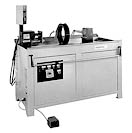| Audit Tips Previous findings – In preparation for an audit, make sure you have included assessing to assure previous audit findings have been abated. Material Certifications – Make sure you have batch certifications for magnetic particle materials that are currently in-use. In general, the last batch added to a container defines the batch for that container. Material Identification – Make sure all containers with materials in them are labeled or traceable to the material and batch number of material they contain. It saves time when the certifications are available for review at the point of use. Audit Checklists – When you are filling out an audit check sheet, it is a value added practice to note where you found the evidence of compliance (e.g. procedure and paragraph references, certification locations, etc.) so evidence can more easily be found and confirmed by an auditor. Make sure you carefully read checklist items to assure you cover verifying compliance completely. For example, consider a requirement that a procedure have the name and address of the facility performing the inspection. It is fairly common to find where the address of the inspection facility is omitted in the procedure. Procedure Process Technique Approval – All procedures and process techniques or instruction sheets used for processing and/or evaluation of components must be approved by a level 3 in most cases. It is important to remember that if you are inspecting parts for an aerospace prime that requires them to approve the level 3, that level 3 must approve the procedure and other instructional documents. If you had a customer approved level 3 and that level 3 no longer works for you, you will have to obtain another approved level 3 and you will likely have to have that person re-approve the previously approved documents. You may have be able to be creative in how you do this with the least amount of administrative work, but be sure the approving customer agrees in writing, your method of approval. Process Parallel Induced Magnetism Method – ASTM E1444-05 revised how to address this method of magnetism. It now requires approval from the engineering organization (Usually from the end user) before its use. If you have legacy techniques using this method of magnetism, be sure you obtain the proper approvals from the engineering organization as described in the ASTM document before continuing its use. Records – Make sure you now record somewhere what specifications were used for the inspection and the revisions of the specification used. This can be in a job log or on a final test report. It is important for a prime customer to be able to trace an inspection to the specific acceptance criteria use at the time a component was inspected. Trainees – When you are training someone in the process and they have a trainee status, make sure you are documenting all training they receive and that they do not independently perform any operations unsupervised, unless detailed appropriate documents are in place and approved by the level 3. Process Control Purchasing and P.O.'s - It is vital to flow down all required technical information on a P.O. to the subcontractor who is providing you with a product or service. Keep in mind that anything required to meet a specification should have that specification referenced either on the P.O. or a document containing the specification requirements should be referenced on the P.O. Examples -
|
|||||||

MT Tips
